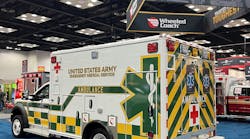You knew it was just a matter of time. A patient with the Ebola virus showed up in the U.S. on Oct. 1. He boarded a flight from Liberia and arrived in the U.S. on Sept. 20. He wasn’t sick on the flight, and had no symptoms when he arrived in Texas. The man died in a hospital on Oct.8.
That is the problem with Ebola – it may take a while for the patient to show symptoms. Symptoms can begin between two to 21 days after infection. The symptoms include fever, muscle pain, headache and a sore throat followed by vomiting, diarrhea, rash, impaired kidney and liver function and in some cases both internal and external bleeding. As of this writing, there have been almost 6,000 cases of Ebola diagnosed in the current outbreak.
Unfortunately for the EMS providers, the Dallas Fire-Rescue ambulance crew who transported the man infected with Ebola to the hospital was exposed and had to take the necessary precautions and be quarantined. They have tested negative for the Ebola virus, according to the City of Dallas. However, the three Dallas firefighters who transported the man to the hospital had to be restricted to their homes while their conditions were observed and while the virus’ incubation period passed. The ambulance crew took all safety precautions and isolated themselves from body fluids.
The ambulance was pulled from service so it could be cleaned properly. According to a Dallas city spokesperson, the patient was vomiting when the ambulance arrived at the hospital, so one could presume there was danger of exposure to body fluids. It will be interesting to see if more patients show with symptoms of the Ebola virus. According to the City of Dallas, as of this writing, 12 to 18 people were being monitored after exposure to the man. Some were members of the initial patient’s family.
We’ve been watching all the news stories come out of west Africa’s coast for the past several months. It started when U.S. healthcare workers were exposed to the virus and were brought back to the U.S. for treatment.
I sense urgency and panic. It seems like the media drives these issues and creates the panic. Contracting Ebola is no different than HIV or hepatitis except you can contract Ebola through the saliva of an infected patient. The main way you can contract the disease is through body fluids, so isolate yourself from the body fluids, contaminated needles, bandages, etc. Ebola is an often-fatal disease; in fact it has about a 50% fatality rate. That is where the panic comes about with the fatality rate and the painful way in which patients die.
The World Health Organization (WHO) says that if you compare how contagious the Ebola virus is to, say SARS or the measles, Ebola just does not stack up. WHO contends the virus is harder to catch than the common cold. That’s because there has been no evidence that Ebola spreads between people through the air. Health experts repeatedly emphasize that human-to-human transmission requires direct contact with infected bodily fluids, including blood, vomit and feces. And to infect, those fluids have to reach a break in the skin or the mucous membranes found around your eyes, mouth and nose.
The U.S. government wasted no time getting information out to the EMS community. On its website, the Centers for Disease Control and Prevention (CDC) started a webpage, “Interim Guidance for Emergency Medical Services (EMS) Systems and 9-1-1 Public Safety Answering Points (PSAPs) for Management of Patients with Known or Suspected Ebola Virus Disease in the United States” (http://www.cdc.gov/vhf/ebola/index.html). The webpage details a plethora of information the background of Ebola; what 9-1-1 public safety answering points (PSAPs) should be considering when screening telephone calls; recommendations for EMS and medical first responders, including firefighters and law enforcement personnel; what to look for when doing patient assessment; issues when EMS transfers patient care to a healthcare facility; items concerning inter-facility transports; infection control; use of personal protective gear; how to clean the EMS vehicle after transporting an Ebola patient; and reporting measures after dealing with an Ebola patient. The CDC also provides a separate webpage that serves as a checklist for EMS agencies.
Even though there should be no panic at this point, preparation within EMS agencies should be underway in the event the disease escalates in the U.S. We live in a mobile society and it is not uncommon to believe that more people may be traveling from the west African coast and showing Ebola signs and symptoms after arriving in the U.S.
For more news and training on EMS, visit http://EMSWorld.com/.






